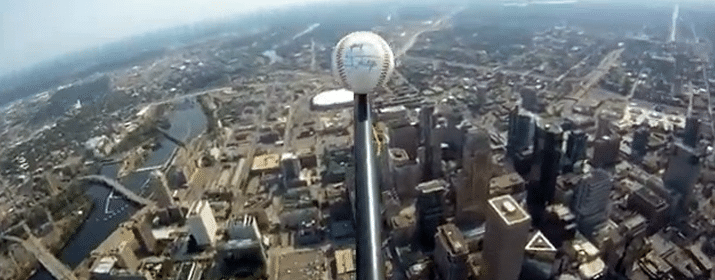In our last post, we talked about the preparation work behind a special balloon launch conducted by students and Dr. James Flaten at a Minnesota Twins game, kicking off the Minnesota Aerospace and Aviation Week and honoring Bob Cabana, Director of Kennedy Space Center.
One of the major concerns before any balloon watch is the weather. It’s predictable, sure, but you never know when something can blow in and ruin a good launch. Fortunately, the weather for this launch was good. The balloon had two GPS trackers and sent down temperature, pressure, and relative humidity information in real time. In addition to the GoPro camera that was zeroed-in on the signed baseball, there were two additional cameras on board acting as backups: a Flip camera pointed toward the ball, and a helmetcam looking down.
Unfortunately, you can never know how things are going to turn out, and the team ran into a major challenge. Before the burst, the balloon encountered a significant amount of turbulence. So much so, in fact, that the GPS tracking unit was violently thrown around and struck the main payload above it numerous times. This knocked the helmetcam off, as well as damaged the sensor pack. Eventually, one of the two GPS trackers tore off, and fell from about 55,000 ft, landing in a soybean field just across the border in Wisconsin. (Dr. Flaten reports that they recovered it and still use it, because they’re tough!)
After one of the GPS tracking devices came loose, footage actually shows that the payload ended up sideways and even upside down a number of times, and the boom arm that held the baseball struck the balloon a number of times, eventually and prematurely popping the balloon at 63,000 ft.
The payload drifted back down to Earth using a parachute. It landed about six miles east of Little Falls, Wisconsin, about 40 miles from the launch location. Recovering the payload actually look several hours, because they didn’t realize the primary GPS tracking devices had become separated from the rest of the payload. The primary GPS tracking device turned off when it hit the ground, and wasn’t recovered until several days later, and the secondary GPS tracker payload was only able to transmit information about a half-mile. But persistence paid off, and they recovered the payload before its batteries died.
In our next and final post about the Twins launch, we’ll talk about the impact this launch had on the city.





